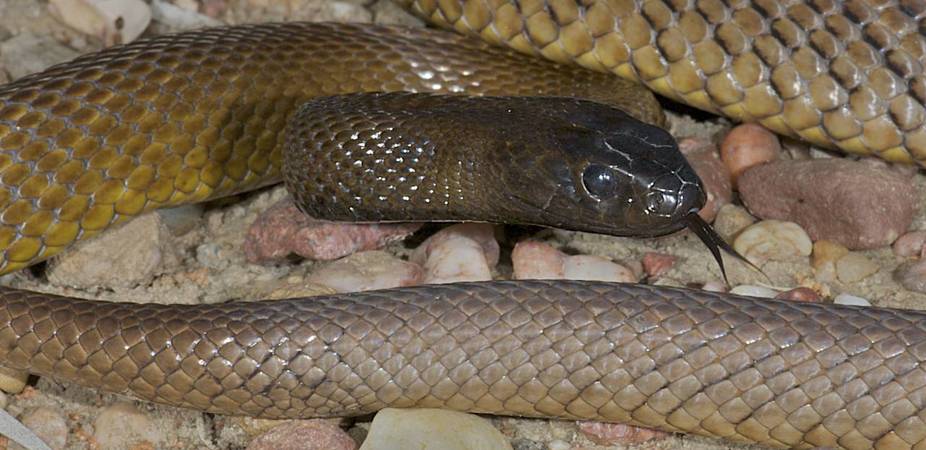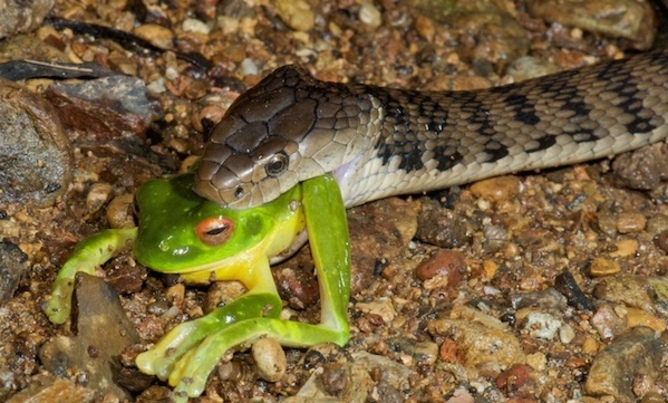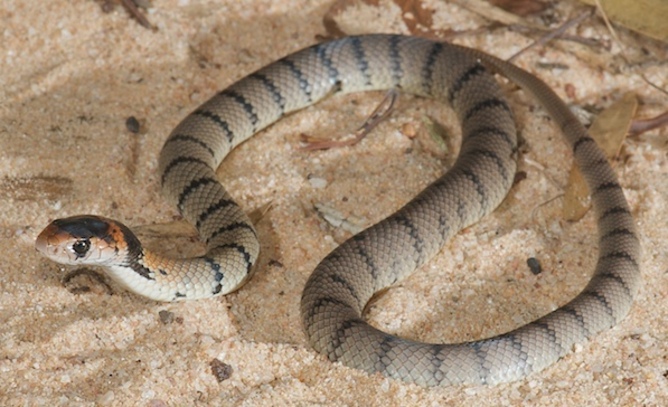
Why are Some Snakes So Venomous?

This article was originally published at The Conversation. The publication contributed the article to Live Science's Expert Voices: Op-Ed & Insights.
Australia is world famous for its venomous critters, including its many highly venomous snakes.
The snake that holds the popular title of “world’s most venomous” is the inland taipan (Oxyuranus microlepidotus), an inhabitant of Australia’s arid interior. Astonishingly, a single bite from an inland taipan is capable of delivering enough venom to kill 250,000 lab mice.
The venom of the inland taipan has attracted considerable research interest and the toxins responsible for its extreme toxicity have been identified. Effective antivenom also exists for the treatment of bites.
What we don’t know, though, is why the inland taipan needs such toxic venom. We know almost nothing about the evolutionary selection pressures that have refined and enhanced the toxins present in the venom of this iconic species of snake.
Snakes vs humans
Historically, the focus of snake venom research worldwide has been anthropocentric – examining the impact the venom has for humans. Large species of venomous snake, those that are known to be potentially dangerous to humans, have received the lion’s share of attention.
Most attention has been given to the development of antivenom and to studying the building blocks of toxic proteins found in snake venoms. This has allowed us to learn more about human physiology and to search for compounds that may be useful in drug design, such as the toxin from the venom of a pit viper from which the blood pressure medication Captopril was developed.
‘Milking’ snakes for antivenom.
These are important goals for venom research, but the result of this bias toward human interest is that we still know very little about the ways in which snakes use their venom in nature. We also do not know how diet influences its composition – the ecology of venom is an almost completely neglected area of research.
We do know that the common ancestor of all snakes possessed a rudimentary venom system. This means that all snakes had an equal evolutionary opportunity to become venomous. That not all snakes developed sophisticated venom delivery systems suggests that being highly venomous is not always the most efficient way for a snake to secure a meal.
There are no herbivorous snakes, but venom is not the only way that snakes can subdue their prey. Many snakes use constriction, as dramatically demonstrated in the recent battle between a python and crocodile in Queensland.
Some snakes simply rely on powerful jaws while others feed on defenceless prey such as eggs, so have no need of any additional deadly method of subjugation.
Snake evolution in Australia
In Australia there is a unique opportunity to study the evolution of snake venom.
The majority of snakes in this country are members of the Elapidae family, which means they have fixed fangs at the front of their mouths, and all are venomous.
The family, which arrived in Australia some 10 million years ago, includes some of the world’s most famous snakes such as the cobras of Asia and Africa and the mambas of Africa.
Like all elapid snakes, the common ancestor of modern Australian species would have possessed a sophisticated venom system capable of delivering a complex cocktail of toxins into potential prey animals.
Elapid snakes quickly diversified in their new environment and today Australia is home to approximately 100 terrestrial species and more than 30 marine species – more than a third of the world’s elapid snake fauna.
Australian elapid snakes are extremely diverse in ecology and prey preference: some are general feeders that will tackle any prey, some prefer mammals, others frogs or reptiles. Some are marine specialists, while others prefer eggs.

Despite the opportunity this diversity represents to study venom ecology, the majority of venom research has focused on large species that are potentially dangerous to humans. As these species are typically generalist feeders, this research has given us little insight into what has shaped the venom in the other species.
So why so toxic?
A popular theory in the past was that snakes simply evolved the most toxic venom possible in order to kill quickly any potential prey they might come across. Occasionally the extreme toxicity of inland taipan venom is still used in support of this “nuclear bomb” theory of snake venom evolution.
But recent research is revealing a strong correlation between prey preference and venom composition. This extends to species with strong shifts in prey preference throughout their lives – if babies and adults specialise on different prey types, they may have different venoms.

At the molecular level, individual toxins have been identified that are 100-fold more toxic to natural prey than to laboratory organisms such as rodents. The evidence suggests that snakes evolve venom that is fine-tuned for the specific context in which it is used.
Why then is the inland taipan so toxic when it targets solely rodents? The precise answer to this question awaits further research, although it is possible to indulge in thought experiments.
The fact that inland taipans specialise on rodents may partly explain their extreme toxicity to lab mice, but there’s probably more to it that that.
In nature, taipans need to kill their relatively dangerous rodent prey quickly, before it escapes or has a chance to retaliate. Living in a harsh, arid environment also means they must conserve resources, so they likely deliver only a tiny fraction of the contents of their glands each time they bite a prey animal.
Inland taipans are also engaged in a co-evolutionary arms race with their natural prey, which may over time have evolved some resistance to the snake’s venom. The hapless laboratory mice used in toxicity testing are evolutionarily naïve and may be much more sensitive to the venom.
So the impressive figure of 250,000 mice per bite is misleading, reflective more of “laboratory reality” than evolutionary reality.
Timothy N. W. Jackson receives funding from Australian Geographic.
This article was originally published on The Conversation. Read the original article. The views expressed are those of the author and do not necessarily reflect the views of the publisher. This version of the article was originally published on Live Science.
Sign up for the Live Science daily newsletter now
Get the world’s most fascinating discoveries delivered straight to your inbox.











